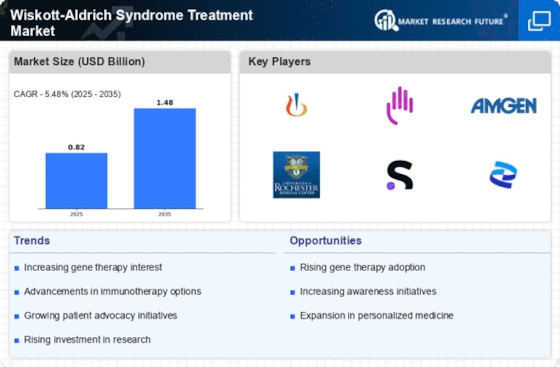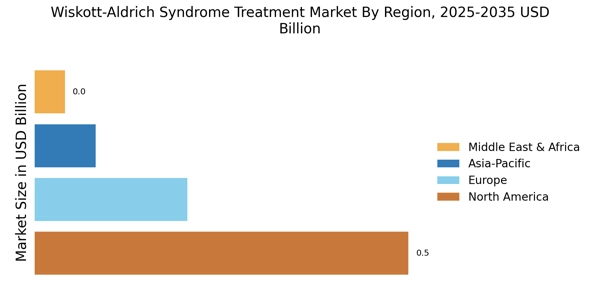Growing Awareness and Diagnosis
The Wiskott-Aldrich Syndrome Treatment Market is benefiting from a growing awareness of the syndrome among healthcare professionals and the general public. Increased educational initiatives and advocacy efforts have led to earlier diagnosis and intervention, which are crucial for improving patient outcomes. As awareness rises, more patients are being identified and treated, thereby expanding the market for therapeutic options. The prevalence of Wiskott-Aldrich Syndrome, although rare, is estimated to affect approximately 1 in 1 million males, highlighting the need for effective treatment solutions. This heightened awareness is likely to drive demand for therapies and support services, further propelling the growth of the Wiskott-Aldrich Syndrome Treatment Market.
Advancements in Genetic Research
The Wiskott-Aldrich Syndrome Treatment Market is experiencing a notable surge due to advancements in genetic research. Recent studies have elucidated the genetic mutations responsible for Wiskott-Aldrich Syndrome, leading to improved diagnostic techniques and targeted therapies. The identification of specific gene mutations has paved the way for innovative treatment options, including gene therapy, which holds promise for long-term management of the condition. As research progresses, the potential for developing personalized treatment regimens tailored to individual genetic profiles becomes increasingly feasible. This evolution in genetic understanding not only enhances patient outcomes but also stimulates investment in the Wiskott-Aldrich Syndrome Treatment Market, as stakeholders recognize the value of precision medicine in addressing rare genetic disorders.
Technological Innovations in Treatment
Technological innovations are playing a pivotal role in shaping the Wiskott-Aldrich Syndrome Treatment Market. The integration of advanced technologies, such as CRISPR gene editing and next-generation sequencing, is revolutionizing treatment approaches. These technologies enable precise modifications at the genetic level, offering potential cures for genetic disorders like Wiskott-Aldrich Syndrome. Furthermore, the development of novel drug delivery systems enhances the efficacy of existing therapies, ensuring that patients receive optimal care. As these innovations continue to evolve, they are expected to attract significant investment and interest from pharmaceutical companies, thereby accelerating the growth of the Wiskott-Aldrich Syndrome Treatment Market.
Increased Funding for Rare Disease Research
The Wiskott-Aldrich Syndrome Treatment Market is witnessing an influx of funding aimed at rare disease research. Governments and private organizations are increasingly recognizing the importance of addressing rare genetic disorders, leading to enhanced financial support for research initiatives. This funding is crucial for the development of new therapies and clinical trials, which are essential for advancing treatment options for Wiskott-Aldrich Syndrome. In recent years, funding for rare disease research has seen a substantial increase, with billions allocated to support innovative projects. This financial backing not only fosters scientific discovery but also encourages collaboration among researchers, ultimately benefiting the Wiskott-Aldrich Syndrome Treatment Market.
Regulatory Support for Innovative Therapies
Regulatory bodies are providing increasing support for the development of innovative therapies within the Wiskott-Aldrich Syndrome Treatment Market. Initiatives aimed at expediting the approval process for orphan drugs and therapies for rare diseases are becoming more prevalent. This regulatory environment encourages pharmaceutical companies to invest in research and development, as the pathway to market for new treatments becomes more streamlined. Additionally, incentives such as tax credits and grants for rare disease research further stimulate innovation. As regulatory frameworks evolve to support the introduction of novel therapies, the Wiskott-Aldrich Syndrome Treatment Market is likely to experience accelerated growth, benefiting patients in need of effective treatment options.


















Leave a Comment